The Importance of Resilience in the Teaching World: An Analysis
VerifiedAdded on 2022/07/29
|6
|1500
|35
Essay
AI Summary
This essay explores the critical role of resilience in the teaching profession, focusing on the challenges faced by educators in today's demanding environment. It begins by defining resilience and highlighting its significance in navigating the stresses of teaching, such as managing students, maintaining work-life balance, and adapting to institutional regulations. The essay delves into the challenges teachers encounter, including heavy workloads and the need to create safe classroom environments. It discusses the importance of protective factors, such as support from colleagues and administrators, and emphasizes the need for teachers to develop adaptability and coping strategies. Furthermore, the essay analyzes how the BRiTE modules can help build resilience through initiatives, such as building relationships and managing emotions. It also highlights the positive impact of resilience on teachers' performance, student achievement, and overall job satisfaction. The essay concludes by emphasizing the shared responsibility of building resilience, involving school staff, administrators, and the teachers themselves, and underscores the need for ongoing professional development and support to ensure the well-being and success of educators.
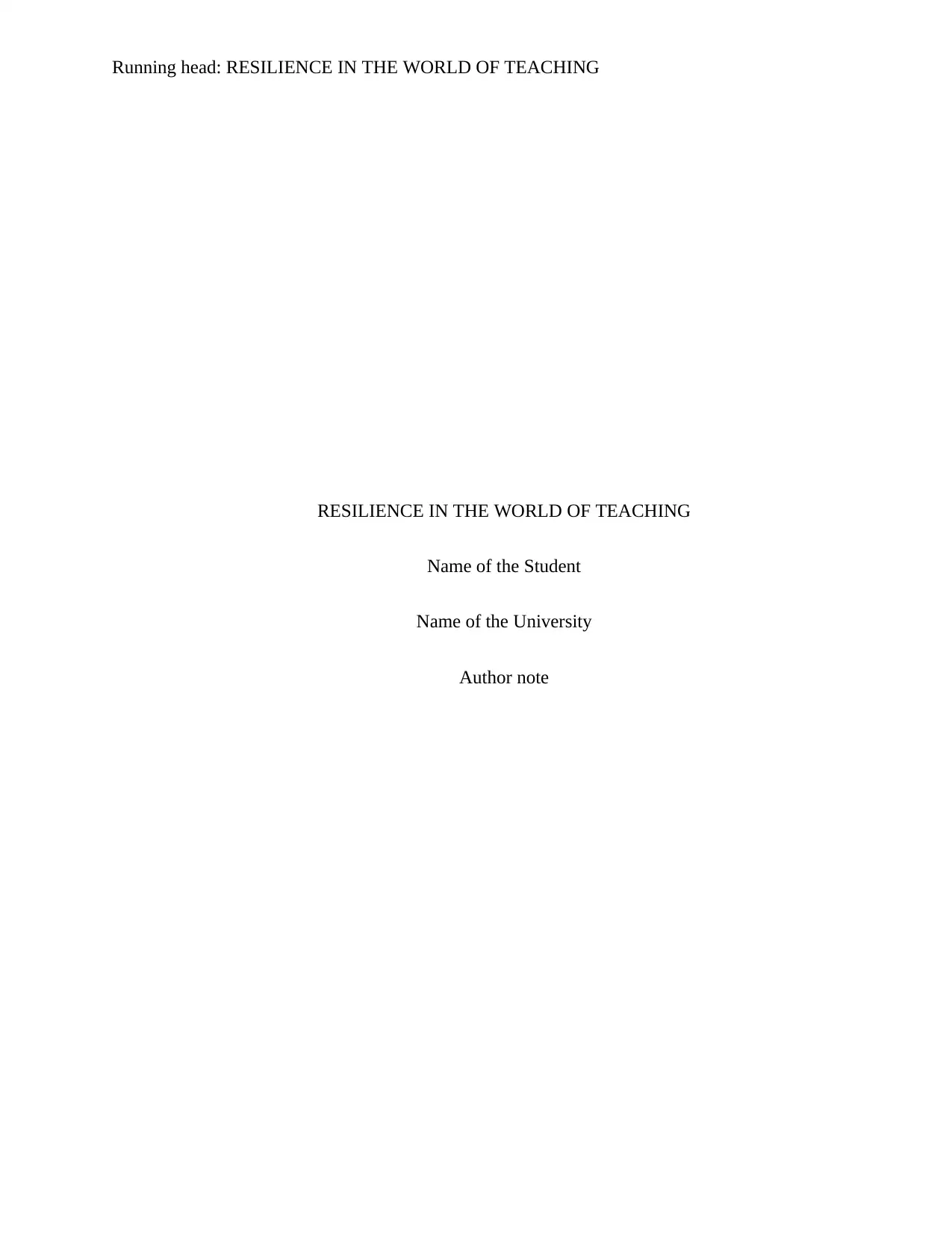
Running head: RESILIENCE IN THE WORLD OF TEACHING
RESILIENCE IN THE WORLD OF TEACHING
Name of the Student
Name of the University
Author note
RESILIENCE IN THE WORLD OF TEACHING
Name of the Student
Name of the University
Author note
Paraphrase This Document
Need a fresh take? Get an instant paraphrase of this document with our AI Paraphraser
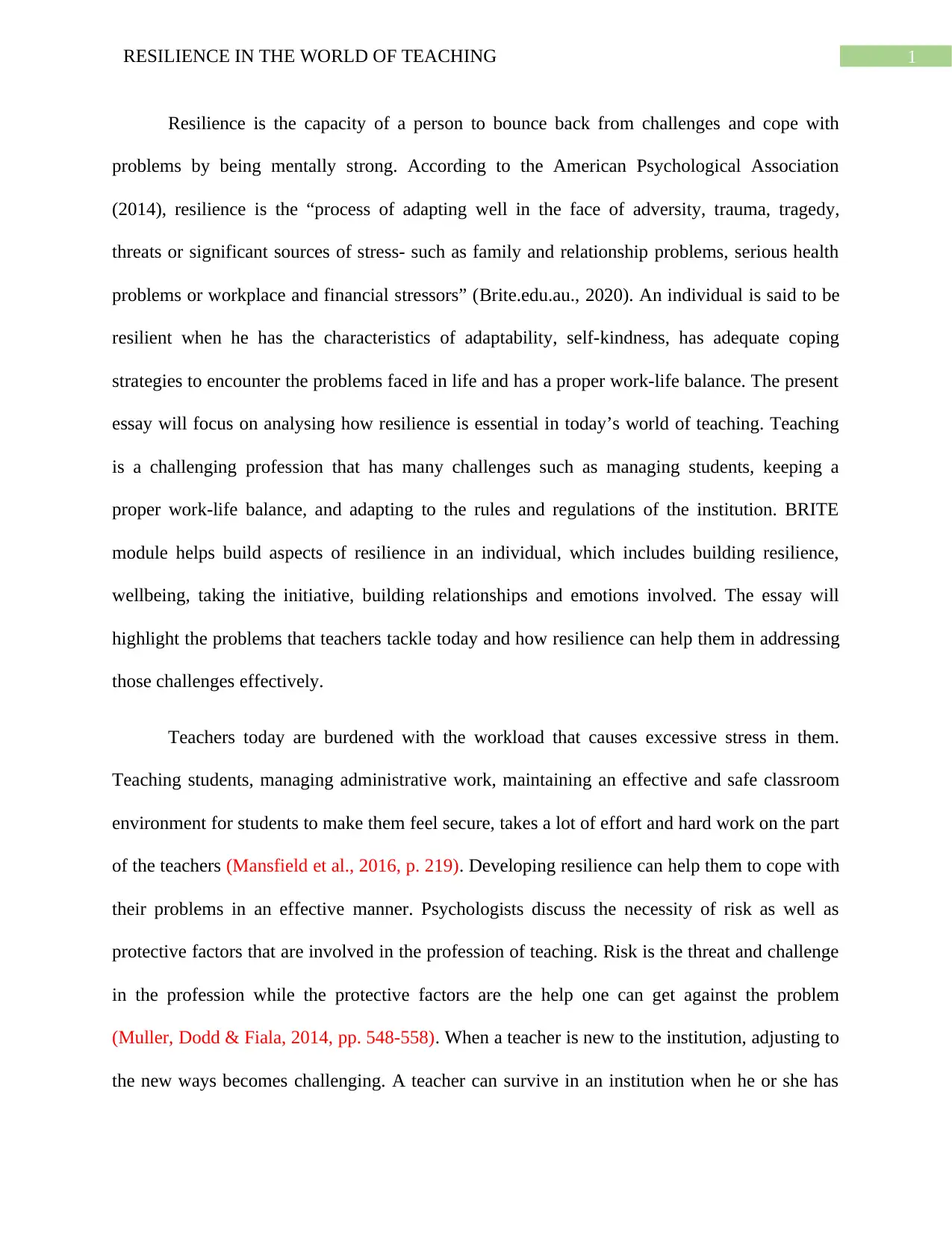
1RESILIENCE IN THE WORLD OF TEACHING
Resilience is the capacity of a person to bounce back from challenges and cope with
problems by being mentally strong. According to the American Psychological Association
(2014), resilience is the “process of adapting well in the face of adversity, trauma, tragedy,
threats or significant sources of stress- such as family and relationship problems, serious health
problems or workplace and financial stressors” (Brite.edu.au., 2020). An individual is said to be
resilient when he has the characteristics of adaptability, self-kindness, has adequate coping
strategies to encounter the problems faced in life and has a proper work-life balance. The present
essay will focus on analysing how resilience is essential in today’s world of teaching. Teaching
is a challenging profession that has many challenges such as managing students, keeping a
proper work-life balance, and adapting to the rules and regulations of the institution. BRITE
module helps build aspects of resilience in an individual, which includes building resilience,
wellbeing, taking the initiative, building relationships and emotions involved. The essay will
highlight the problems that teachers tackle today and how resilience can help them in addressing
those challenges effectively.
Teachers today are burdened with the workload that causes excessive stress in them.
Teaching students, managing administrative work, maintaining an effective and safe classroom
environment for students to make them feel secure, takes a lot of effort and hard work on the part
of the teachers (Mansfield et al., 2016, p. 219). Developing resilience can help them to cope with
their problems in an effective manner. Psychologists discuss the necessity of risk as well as
protective factors that are involved in the profession of teaching. Risk is the threat and challenge
in the profession while the protective factors are the help one can get against the problem
(Muller, Dodd & Fiala, 2014, pp. 548-558). When a teacher is new to the institution, adjusting to
the new ways becomes challenging. A teacher can survive in an institution when he or she has
Resilience is the capacity of a person to bounce back from challenges and cope with
problems by being mentally strong. According to the American Psychological Association
(2014), resilience is the “process of adapting well in the face of adversity, trauma, tragedy,
threats or significant sources of stress- such as family and relationship problems, serious health
problems or workplace and financial stressors” (Brite.edu.au., 2020). An individual is said to be
resilient when he has the characteristics of adaptability, self-kindness, has adequate coping
strategies to encounter the problems faced in life and has a proper work-life balance. The present
essay will focus on analysing how resilience is essential in today’s world of teaching. Teaching
is a challenging profession that has many challenges such as managing students, keeping a
proper work-life balance, and adapting to the rules and regulations of the institution. BRITE
module helps build aspects of resilience in an individual, which includes building resilience,
wellbeing, taking the initiative, building relationships and emotions involved. The essay will
highlight the problems that teachers tackle today and how resilience can help them in addressing
those challenges effectively.
Teachers today are burdened with the workload that causes excessive stress in them.
Teaching students, managing administrative work, maintaining an effective and safe classroom
environment for students to make them feel secure, takes a lot of effort and hard work on the part
of the teachers (Mansfield et al., 2016, p. 219). Developing resilience can help them to cope with
their problems in an effective manner. Psychologists discuss the necessity of risk as well as
protective factors that are involved in the profession of teaching. Risk is the threat and challenge
in the profession while the protective factors are the help one can get against the problem
(Muller, Dodd & Fiala, 2014, pp. 548-558). When a teacher is new to the institution, adjusting to
the new ways becomes challenging. A teacher can survive in an institution when he or she has
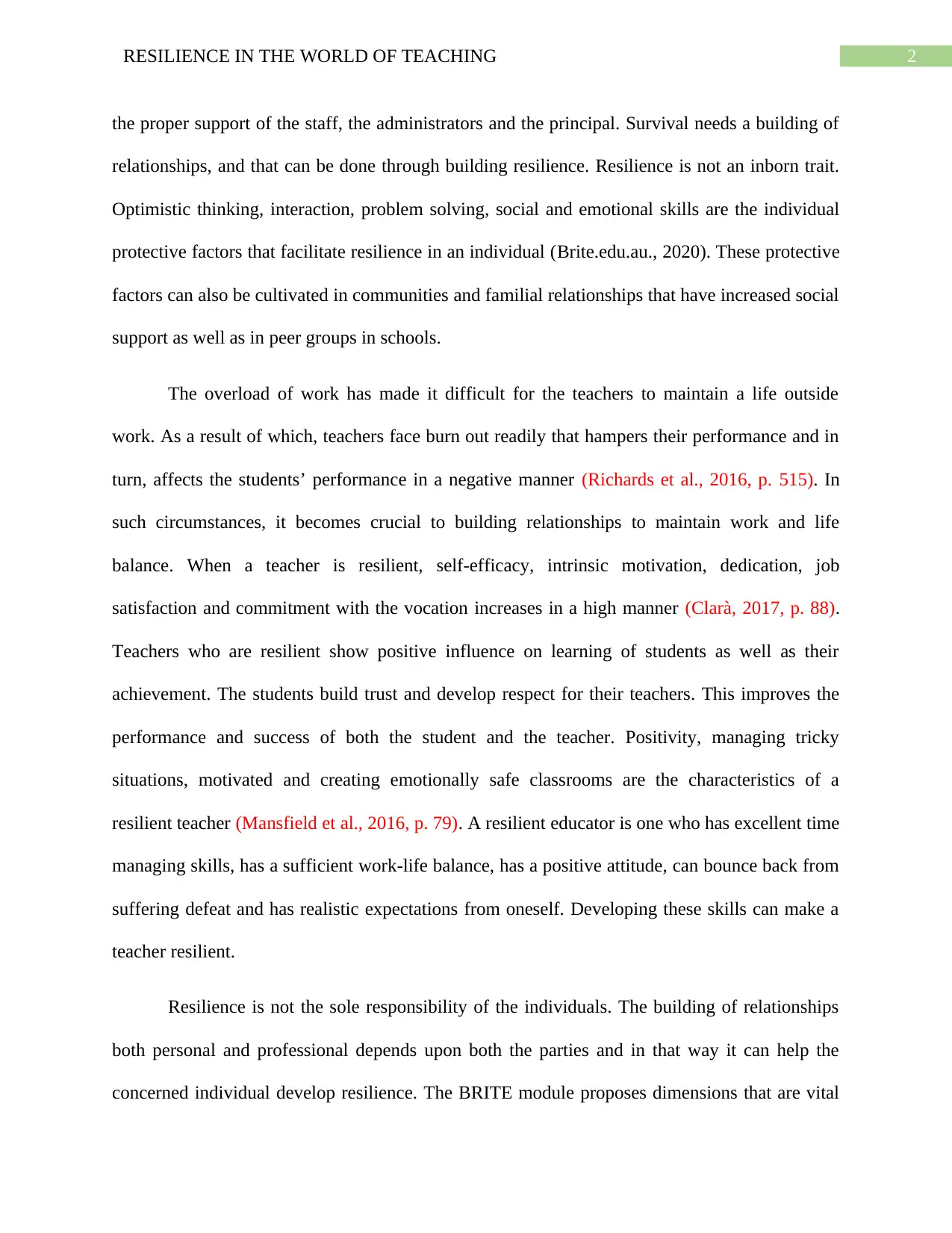
2RESILIENCE IN THE WORLD OF TEACHING
the proper support of the staff, the administrators and the principal. Survival needs a building of
relationships, and that can be done through building resilience. Resilience is not an inborn trait.
Optimistic thinking, interaction, problem solving, social and emotional skills are the individual
protective factors that facilitate resilience in an individual (Brite.edu.au., 2020). These protective
factors can also be cultivated in communities and familial relationships that have increased social
support as well as in peer groups in schools.
The overload of work has made it difficult for the teachers to maintain a life outside
work. As a result of which, teachers face burn out readily that hampers their performance and in
turn, affects the students’ performance in a negative manner (Richards et al., 2016, p. 515). In
such circumstances, it becomes crucial to building relationships to maintain work and life
balance. When a teacher is resilient, self-efficacy, intrinsic motivation, dedication, job
satisfaction and commitment with the vocation increases in a high manner (Clarà, 2017, p. 88).
Teachers who are resilient show positive influence on learning of students as well as their
achievement. The students build trust and develop respect for their teachers. This improves the
performance and success of both the student and the teacher. Positivity, managing tricky
situations, motivated and creating emotionally safe classrooms are the characteristics of a
resilient teacher (Mansfield et al., 2016, p. 79). A resilient educator is one who has excellent time
managing skills, has a sufficient work-life balance, has a positive attitude, can bounce back from
suffering defeat and has realistic expectations from oneself. Developing these skills can make a
teacher resilient.
Resilience is not the sole responsibility of the individuals. The building of relationships
both personal and professional depends upon both the parties and in that way it can help the
concerned individual develop resilience. The BRITE module proposes dimensions that are vital
the proper support of the staff, the administrators and the principal. Survival needs a building of
relationships, and that can be done through building resilience. Resilience is not an inborn trait.
Optimistic thinking, interaction, problem solving, social and emotional skills are the individual
protective factors that facilitate resilience in an individual (Brite.edu.au., 2020). These protective
factors can also be cultivated in communities and familial relationships that have increased social
support as well as in peer groups in schools.
The overload of work has made it difficult for the teachers to maintain a life outside
work. As a result of which, teachers face burn out readily that hampers their performance and in
turn, affects the students’ performance in a negative manner (Richards et al., 2016, p. 515). In
such circumstances, it becomes crucial to building relationships to maintain work and life
balance. When a teacher is resilient, self-efficacy, intrinsic motivation, dedication, job
satisfaction and commitment with the vocation increases in a high manner (Clarà, 2017, p. 88).
Teachers who are resilient show positive influence on learning of students as well as their
achievement. The students build trust and develop respect for their teachers. This improves the
performance and success of both the student and the teacher. Positivity, managing tricky
situations, motivated and creating emotionally safe classrooms are the characteristics of a
resilient teacher (Mansfield et al., 2016, p. 79). A resilient educator is one who has excellent time
managing skills, has a sufficient work-life balance, has a positive attitude, can bounce back from
suffering defeat and has realistic expectations from oneself. Developing these skills can make a
teacher resilient.
Resilience is not the sole responsibility of the individuals. The building of relationships
both personal and professional depends upon both the parties and in that way it can help the
concerned individual develop resilience. The BRITE module proposes dimensions that are vital
⊘ This is a preview!⊘
Do you want full access?
Subscribe today to unlock all pages.

Trusted by 1+ million students worldwide
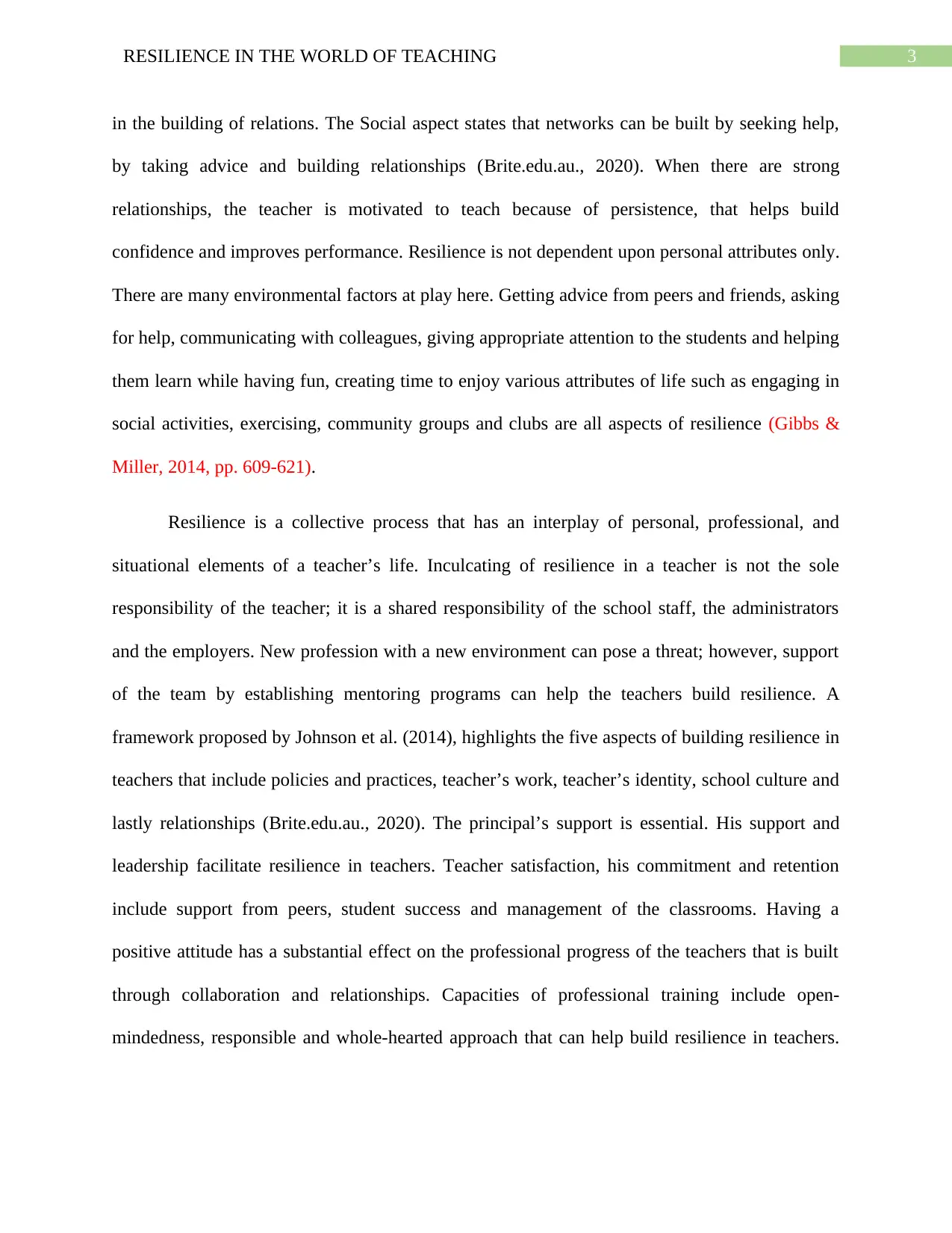
3RESILIENCE IN THE WORLD OF TEACHING
in the building of relations. The Social aspect states that networks can be built by seeking help,
by taking advice and building relationships (Brite.edu.au., 2020). When there are strong
relationships, the teacher is motivated to teach because of persistence, that helps build
confidence and improves performance. Resilience is not dependent upon personal attributes only.
There are many environmental factors at play here. Getting advice from peers and friends, asking
for help, communicating with colleagues, giving appropriate attention to the students and helping
them learn while having fun, creating time to enjoy various attributes of life such as engaging in
social activities, exercising, community groups and clubs are all aspects of resilience (Gibbs &
Miller, 2014, pp. 609-621).
Resilience is a collective process that has an interplay of personal, professional, and
situational elements of a teacher’s life. Inculcating of resilience in a teacher is not the sole
responsibility of the teacher; it is a shared responsibility of the school staff, the administrators
and the employers. New profession with a new environment can pose a threat; however, support
of the team by establishing mentoring programs can help the teachers build resilience. A
framework proposed by Johnson et al. (2014), highlights the five aspects of building resilience in
teachers that include policies and practices, teacher’s work, teacher’s identity, school culture and
lastly relationships (Brite.edu.au., 2020). The principal’s support is essential. His support and
leadership facilitate resilience in teachers. Teacher satisfaction, his commitment and retention
include support from peers, student success and management of the classrooms. Having a
positive attitude has a substantial effect on the professional progress of the teachers that is built
through collaboration and relationships. Capacities of professional training include open-
mindedness, responsible and whole-hearted approach that can help build resilience in teachers.
in the building of relations. The Social aspect states that networks can be built by seeking help,
by taking advice and building relationships (Brite.edu.au., 2020). When there are strong
relationships, the teacher is motivated to teach because of persistence, that helps build
confidence and improves performance. Resilience is not dependent upon personal attributes only.
There are many environmental factors at play here. Getting advice from peers and friends, asking
for help, communicating with colleagues, giving appropriate attention to the students and helping
them learn while having fun, creating time to enjoy various attributes of life such as engaging in
social activities, exercising, community groups and clubs are all aspects of resilience (Gibbs &
Miller, 2014, pp. 609-621).
Resilience is a collective process that has an interplay of personal, professional, and
situational elements of a teacher’s life. Inculcating of resilience in a teacher is not the sole
responsibility of the teacher; it is a shared responsibility of the school staff, the administrators
and the employers. New profession with a new environment can pose a threat; however, support
of the team by establishing mentoring programs can help the teachers build resilience. A
framework proposed by Johnson et al. (2014), highlights the five aspects of building resilience in
teachers that include policies and practices, teacher’s work, teacher’s identity, school culture and
lastly relationships (Brite.edu.au., 2020). The principal’s support is essential. His support and
leadership facilitate resilience in teachers. Teacher satisfaction, his commitment and retention
include support from peers, student success and management of the classrooms. Having a
positive attitude has a substantial effect on the professional progress of the teachers that is built
through collaboration and relationships. Capacities of professional training include open-
mindedness, responsible and whole-hearted approach that can help build resilience in teachers.
Paraphrase This Document
Need a fresh take? Get an instant paraphrase of this document with our AI Paraphraser
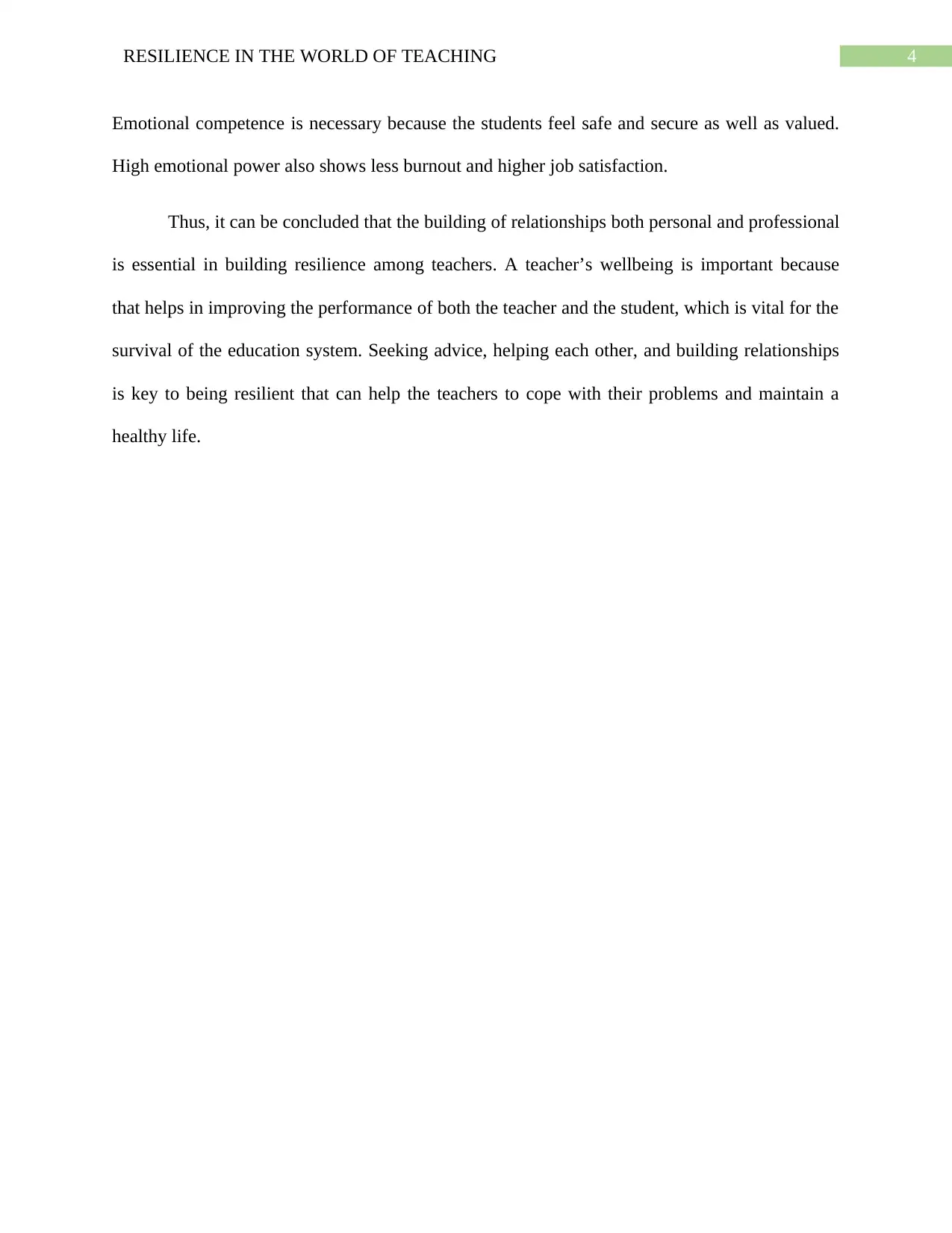
4RESILIENCE IN THE WORLD OF TEACHING
Emotional competence is necessary because the students feel safe and secure as well as valued.
High emotional power also shows less burnout and higher job satisfaction.
Thus, it can be concluded that the building of relationships both personal and professional
is essential in building resilience among teachers. A teacher’s wellbeing is important because
that helps in improving the performance of both the teacher and the student, which is vital for the
survival of the education system. Seeking advice, helping each other, and building relationships
is key to being resilient that can help the teachers to cope with their problems and maintain a
healthy life.
Emotional competence is necessary because the students feel safe and secure as well as valued.
High emotional power also shows less burnout and higher job satisfaction.
Thus, it can be concluded that the building of relationships both personal and professional
is essential in building resilience among teachers. A teacher’s wellbeing is important because
that helps in improving the performance of both the teacher and the student, which is vital for the
survival of the education system. Seeking advice, helping each other, and building relationships
is key to being resilient that can help the teachers to cope with their problems and maintain a
healthy life.
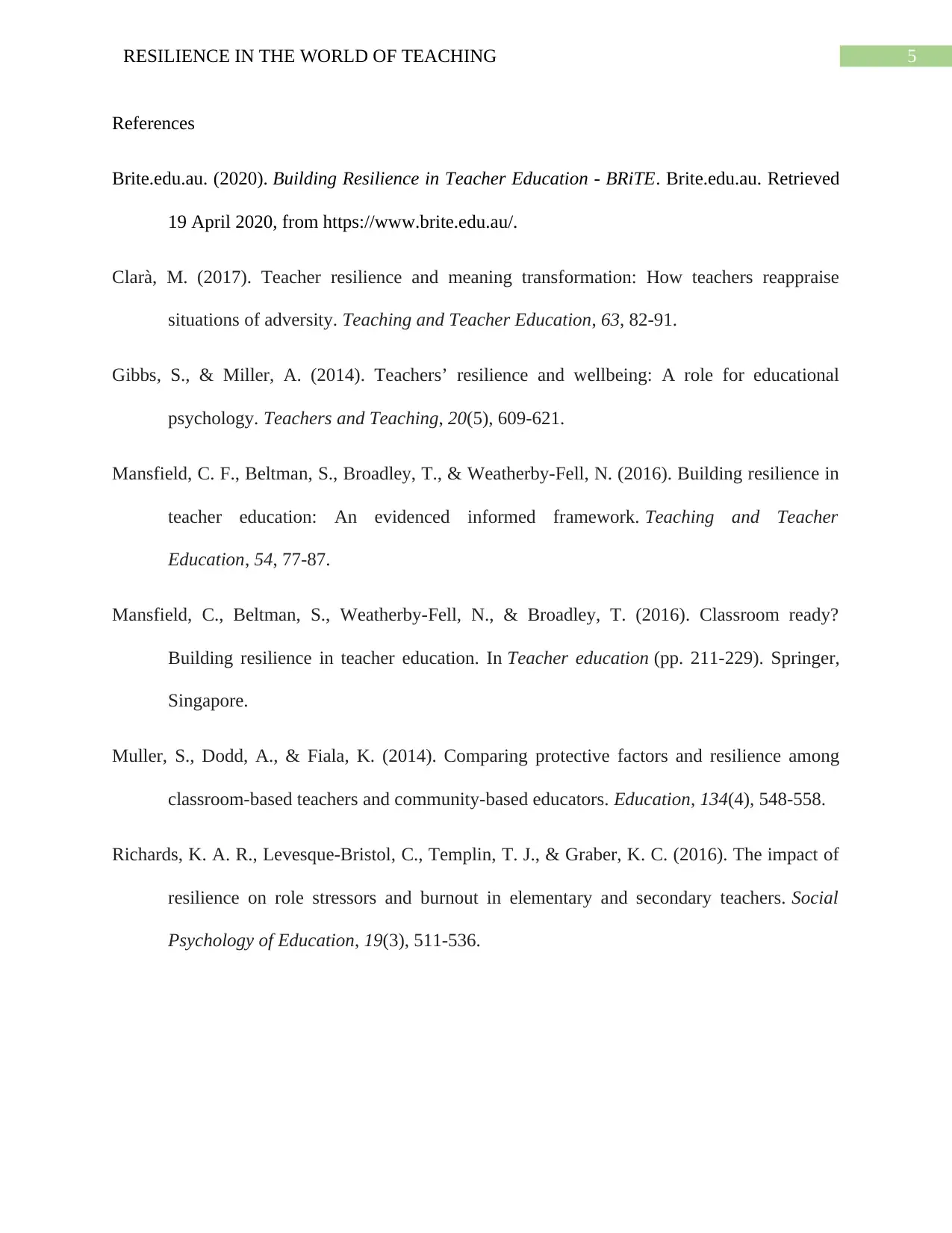
5RESILIENCE IN THE WORLD OF TEACHING
References
Brite.edu.au. (2020). Building Resilience in Teacher Education - BRiTE. Brite.edu.au. Retrieved
19 April 2020, from https://www.brite.edu.au/.
Clarà, M. (2017). Teacher resilience and meaning transformation: How teachers reappraise
situations of adversity. Teaching and Teacher Education, 63, 82-91.
Gibbs, S., & Miller, A. (2014). Teachers’ resilience and wellbeing: A role for educational
psychology. Teachers and Teaching, 20(5), 609-621.
Mansfield, C. F., Beltman, S., Broadley, T., & Weatherby-Fell, N. (2016). Building resilience in
teacher education: An evidenced informed framework. Teaching and Teacher
Education, 54, 77-87.
Mansfield, C., Beltman, S., Weatherby-Fell, N., & Broadley, T. (2016). Classroom ready?
Building resilience in teacher education. In Teacher education (pp. 211-229). Springer,
Singapore.
Muller, S., Dodd, A., & Fiala, K. (2014). Comparing protective factors and resilience among
classroom-based teachers and community-based educators. Education, 134(4), 548-558.
Richards, K. A. R., Levesque-Bristol, C., Templin, T. J., & Graber, K. C. (2016). The impact of
resilience on role stressors and burnout in elementary and secondary teachers. Social
Psychology of Education, 19(3), 511-536.
References
Brite.edu.au. (2020). Building Resilience in Teacher Education - BRiTE. Brite.edu.au. Retrieved
19 April 2020, from https://www.brite.edu.au/.
Clarà, M. (2017). Teacher resilience and meaning transformation: How teachers reappraise
situations of adversity. Teaching and Teacher Education, 63, 82-91.
Gibbs, S., & Miller, A. (2014). Teachers’ resilience and wellbeing: A role for educational
psychology. Teachers and Teaching, 20(5), 609-621.
Mansfield, C. F., Beltman, S., Broadley, T., & Weatherby-Fell, N. (2016). Building resilience in
teacher education: An evidenced informed framework. Teaching and Teacher
Education, 54, 77-87.
Mansfield, C., Beltman, S., Weatherby-Fell, N., & Broadley, T. (2016). Classroom ready?
Building resilience in teacher education. In Teacher education (pp. 211-229). Springer,
Singapore.
Muller, S., Dodd, A., & Fiala, K. (2014). Comparing protective factors and resilience among
classroom-based teachers and community-based educators. Education, 134(4), 548-558.
Richards, K. A. R., Levesque-Bristol, C., Templin, T. J., & Graber, K. C. (2016). The impact of
resilience on role stressors and burnout in elementary and secondary teachers. Social
Psychology of Education, 19(3), 511-536.
⊘ This is a preview!⊘
Do you want full access?
Subscribe today to unlock all pages.

Trusted by 1+ million students worldwide
1 out of 6
Related Documents
Your All-in-One AI-Powered Toolkit for Academic Success.
+13062052269
info@desklib.com
Available 24*7 on WhatsApp / Email
![[object Object]](/_next/static/media/star-bottom.7253800d.svg)
Unlock your academic potential
Copyright © 2020–2025 A2Z Services. All Rights Reserved. Developed and managed by ZUCOL.





